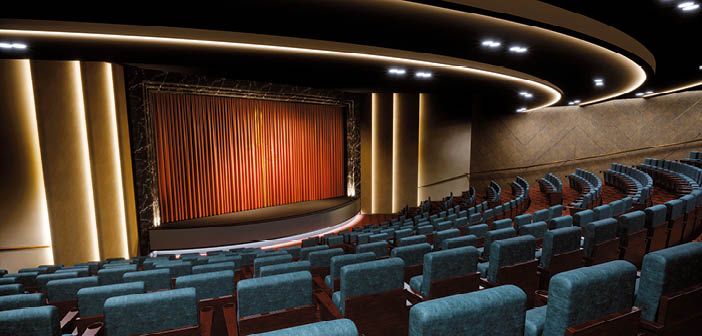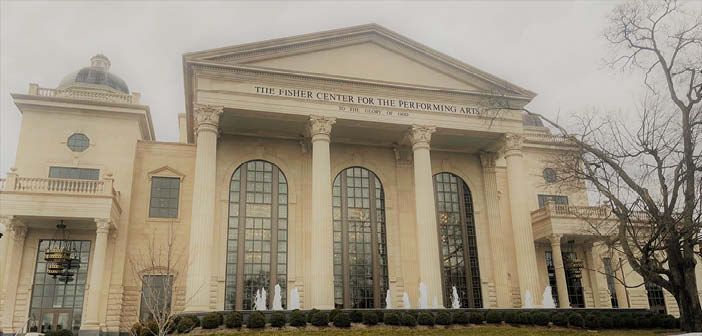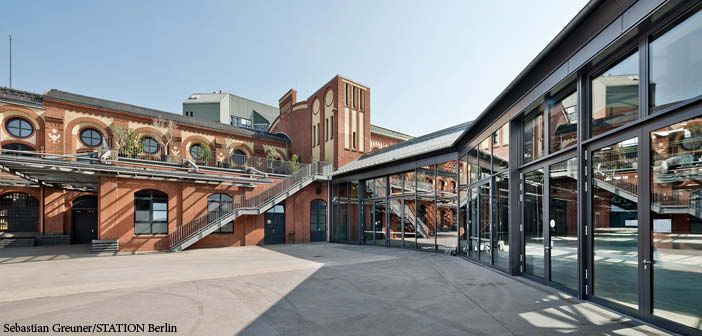Darren Harvey, project manager at Creative Project Design, details the design of the entertainment spaces on board Saga’s Spirit of Discovery cruise ship
What were Saga’s requirements for the equipment?
Saga was very clear that quality is at the heart of what it does, so meeting the brief was not just a case of finding reliable technology, it also had to deliver the very best experience for the audience. Not only do the venues on board have to deliver a consistently high-quality entertainment product, but they have to do it all over the world, in all weather conditions and without a day off!
The venues on board are numerous and varied, each with a unique character, ambience and entertainment offering. From a technology perspective they are also versatile, flexible and as futureproof as possible. The technology concepts are built to last the life of the ship and to cater for the entertainment needs of both now and for the years to come.
How did you balance aesthetic and practical demands?
Saga has created a beautiful ship and at all stages of the design process we work closely with the architect to ensure that the entertainment technology is cleverly hidden and integrated within the room. This is a big part of the brief and often we will work with manufacturers to find or commission products that fit into specific recesses, under furniture, inside niches, behind panels and so on. Whilst doing this we also have to ensure that access is available for maintenance and inspection and that of course the systems still function correctly. Another big part of the design process is coordination with other departments, as behind every decorated wall or ceiling is usually a network of cables, pipes, safety systems, services and steelwork – all of which are competing for space with the entertainment technology.
How have you planned for ease of use?
Operating all the technical equipment is no small task and Saga have skilled technicians, often with many years of training and experience, to ensure that the systems are well maintained and used to their full potential. Much of the equipment is from industry-leading brands but put together in a bespoke way. Equipment is also specified based on functionality, previous experience, case studies and known levels of support around the world. Reliability is a huge factor as spare parts or replacements are hard to come by in the middle of the Atlantic Ocean.
Much of the technology has very advanced features but also presets and regular functions that can be recalled very easily – these are often integrated into a touch panel control, enabling, for example, bar or spa staff to adjust the background music in their area with a single action, whilst still enabling an experienced engineer a full suite of control.
We only get one chance to build the ship so it’s essential to include as much functionality and reliability at the design stage as possible. We always try to ensure that creative directors – both now and in 15 years’ time – have a modern and versatile platform to deliver their shows. This means identifying potential future trends, building in expandability and futureproofing wherever possible.
Was energy efficiency important?
We actively investigated and implemented ways to reduce fuel usage to minimise both the environmental and financial impact of the entertainment systems. For example, we used exclusively LED technology for the stage lighting, worked with manufacturers to reduce the weight of systems, implemented digital power controls to enable operators to more easily shut down equipment when not in use and specified equipment that requires minimal consumables to be shipped and delivered, for example rechargeable battery packs.
How often will the theatre be used?
Saga’s brief was to have a West End standard theatre that can deliver everything from high-quality cinema to Broadway musicals, lectures and seminars, rock and roll bands, classical recitals and almost anything else you can think of.
The plan is to use it day and night, 365 days a year. This demanding schedule is much busier than that of most venues on land and when the huge variety of entertainment is factored in, it makes a theatre at sea one of the most extreme environments for entertainment technology.
How did regulations inform the design?
Rules and regulations influence and guide every aspect of ship design, including the entertainment systems. Many of the regulations are the same as building regulations on land, for example head-height clearances, however many are unique to ships and are very strictly adhered to. All equipment – from consoles to pianos – has to be fixed securely so it won’t become loose when the ship is moving. The design has to be verified early on as moving things later can be challenging. The construction has to be adapted during design to facilitate these securing points and the forces that may be excerpted.
There is an established standard for everything from cables to paint and we therefore work with the shipyard and relevant authorities to ensure that everything is compliant and suitable for use at sea.
Another important set of regulations is the categorisation of spaces and what is permitted to be placed where. Amplifiers and back-of-house electrical equipment is located in specially appointed steel rooms along with dedicated cooling units, safety systems and access routes. It would be easy for all of these rooms and spaces to quickly form a maze, so we work hard in the design phase to ensure that the layout is functional and logical, whilst complying with the regulations.
It is also very difficult to add new cables after the design is frozen or indeed to penetrate through walls, ceilings or floors, as the ship is sealed into various watertight/fireproof compartments which may not be immediately obvious to a guest however are always present and inform much of the design.
Safety is at the heart of everything we all do in the design phase and there is regular dialogue all the way through the process with various experts and organisations such as MCA, SOLAS, USPH and so on. These organisations regularly inspect the designs and the ship and also have the power to stop a ship from sailing at any point if they have concerns.
What equipment was specified?
The equipment includes Digico audio consoles, GrandMA lighting consoles, Robe stage lighting, Martin Audio speakers and amplifiers, QSC QSys audio DSP and networking and Green Hippo media servers.
While much of the equipment is established and proven within the industry, the configuration, layout and design of the system is completely bespoke for Saga. Every connection, stage box, feature and function has been specifically tailored to the venue to aid operation, quality and reliability. A lot of the equipment is digital and can be modelled and configured in advance of installation and even tested in virtual reality to ensure the best results on site. Lighting designers can pre-programme before embarking the ship and audio engineers can create their show file with all of their settings in advance if desired. This enables the venue to stay ‘live’ for longer and also reduces the amount of work and personnel on site when producing new entertainment.
Much of the passenger-facing equipment has been aesthetically customised to blend in to its surroundings – all of the speakers are colour-matched to their surroundings and even brackets and cables are customised to make sure that everything is placed perfectly, safely and discretely.
We also spend time with the shipyard to customise foundations of equipment, particularly subwoofers, to minimise the transmission of noise and vibrations to the ship’s steel and surrounding rooms. The technology in some of these foundations and mountings is ultra-modern and comes from precision industries where vibration and noise need to be eliminated from manufacturing machines.
The supplier and integrator of the entertainment equipment was Wartsila-Funa, working under the direction of the shipyard. They have many years of experience in shipbuilding and have installed venues for some of the best-known cruise brands. During the build, the schedule and deadlines are very strict and in most cases dependant on many other departments and builders completing their part. There are not many integrators that are able to install such a range and complexity of technology in the timeframe and environment of a shipyard.
How did the design and installation process unfold?
The process of designing and coordinating the entertainment technology begins several years before delivery, before the construction even begins. There are a range of factors to be considered and finding an appropriate balance is what we all strive to achieve. Some of the factors which feed into the design are safety and adherence to regulations; architectural vision; steel constraints; weight, heat and power budgets; the intended venue usage; initial and lifetime costs; consideration for surrounding spaces; storage, dressing and electrical cabinet space; operation and workflow for technicians; harmonisation and synergy of systems across the ship and fleet where practical; reliability, maintenance and longevity of systems; and futureproofing, including sufficient expandability.
We work very closely with the architect to create technical drawings and plans and there is a considered development process, starting with the largest fixed items and eventually getting down to antennae and connection plates and everything in between. The architect will often make suggestions for positioning and concealment of equipment in the guest areas and we will often facilitate this by customising a product or finding alternative products to fit the space. The architect may also design bespoke fabrics for speaker covers or add architectural elements to the room to hide an ugly entertainment box.
Throughout the process things are shuffled, added, removed and modelled until we get a detailed set of drawings that fulfils everyone’s operational brief and looks great. These drawings are reviewed by the shipyard throughout the process and they ultimately build it all. Everything follows a very precise timeline. During this process we are on hand to react to any matters arising such as fine tuning of placements, tweaking the functionality and managing obsolescence throughout the process.
Installation of the equipment happens very quickly and to the highest standard. Once complete, we thoroughly inspect and test every part. Every cable has its own unique number and is fully tested and signed off. Every speaker, light, plug, socket and line of programming is checked, tested and reported on.
What factors are unique to the design of theatrical spaces on a ship?
There are many unique factors, not least that everything moves around. Space is also at a premium with venues backing directly onto other areas with a sheet of steel in between. Steel surrounds all of the venues on all six sides and presents particular challenges for sound quality. We spend a lot of time thinking about acoustics and using techniques such as breaking up flat surfaces, adding soft furnishings, strengthening ceiling tiles to avoid vibrations, evaluating speaker placement and even perforating steel in key locations to obtain the best acoustics. There is also quite a high noise floor on a ship, coming from things such as air conditioning systems and the engines.
All ships also have a natural vibration or resonance. On modern ships this is not normally perceptible to people, but sensitive electrical equipment can be damaged over time. To help mitigate this, anti-vibration mountings are placed under equipment racks and tolerances are built into various mountings to allow, for example, a whole projector to gently resonate rather than shake itself apart internally. In the past, dry solder joints were very common inside equipment used on board, however nowadays this has largely been mitigated.
A ship’s power supply is often not the same as that used on land and power conditioning, as well as lots of UPS units, are used throughout the entertainment system. The audio system has its own dedicated power connection from the ship’s generators and everything is monitored closely from the ship’s control room. Another important consideration is that a ship’s general power supply can be either 110V or 230V, but is generally at 60Hz, which particularly influences the specification of video equipment.
While the passengers have a feeling of space in the theatre, everything back of house is carefully calculated to make use of every last millimetre. Clever set design, modular staging, innovative storage solutions, split-level floors, overhead hoists and scenic lifts are all used to reduce the storage footprint. If you run out of space you can’t build an extension or knock the back wall down on a ship!





